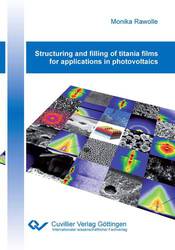| Areas | |
|---|---|
| Serie de libros (96) |
1378
|
| Nachhaltigkeit |
3
|
| Gesundheitswesen |
1
|
| Letra |
2365
|
| Ciencias Naturales |
5406
|
| Matemática | 229 |
| Informática | 319 |
| Física | 980 |
| Química | 1363 |
| Geociencias | 131 |
| Medicina humana | 243 |
| Estomatología | 10 |
| Veterinaria | 108 |
| Farmacia | 147 |
| Biología | 835 |
| Bioquímica, biología molecular, tecnología genética | 121 |
| Biofísica | 25 |
| Nutrición | 45 |
| Agricultura | 1004 |
| Silvicultura | 201 |
| Horticultura | 20 |
| Ecología y conservación de la tierra | 148 |
| Ciencias Ingeniería |
1793
|
| General |
98
|
|
Leitlinien Unfallchirurgie
5. Auflage bestellen |
|
Erweiterte Suche
Structuring and filling of titania films for applications in photovoltaics (Tienda española)
Monika Rawolle (Autor)Previo
Lectura de prueba, PDF (540 KB)
Indice, PDF (50 KB)
Kurzbeschreibung
Die Möglichkeiten, Titandioxid Nanostrukturen zu synthetisieren, sowie die erhaltenen Strukturen rückzubefüllen, werden mit Hinblick auf Anwendungen in der Photovoltaik in der vorliegenden Arbeit untersucht. Auf Titandioxid basierende Solarzellen werden in Hybridsolarzellen und in Farbstoffsolarzellen unterteilt. Das Hauptaugenmerk der Untersuchungen liegt auf der Korrelation zwischen Morphologie und Funktion der resultierenden Strukturen.
Die verschiedenen untersuchten Systeme und die damit verbundenen Fragestellungen umfassen zum einen die Strukturierung von Titandioxid und zum anderen das Rückbefüllen dieser Strukturen. Die Synthese von Titandioxid wird mittels Sol-Gel Chemie vorgenommen. Die Strukturen werden in der Synthese durch Blockcopolymertemplate vorgegeben. Die damit hergestellten dünnen Filme von Titandioxid zeigen eine hohe Porosität, mit einer Schwammartigen Morphologie die sowohl Mesoporen als auch Makroporen aufweist. Die Strukturen werden in dünnen Filmen und in einem nanostrukturierten Tropfen untersucht. Eine Verbesserung der Strukturen durch die Kombination der Sol-Gel Synthese mit Mikrofluidik wird ebenfalls diskutiert. Zudem wird eine mögliche Syntheseroute bei niedrigen Temperaturen vorgestellt, die es erlaubt kristallines Titandioxid zu erhalten. Die Stabilität der Strukturen gegen die Kapillarkräfte bei der Infiltrierung von Wasserdampf wird getestet. Um funktionierende Solarzellen zu erhalten, müssen die Titandioxidnanostrukturen mit einem lochleitenden Material gefüllt werden. Der Grad der Rückbefüllung mit lochleitenden Materialien korreliert mit der Funktion in Solarzellen.
Description
In the presented thesis, the possibilities to synthesize titania nanostructures and the possibilities to fill the resulting nanostructures by other materials are investigated for photovoltaic applications. The solar cells based on titania are distinguished either as hybrid or as dye-sensitized solar cells. The main focus of the investigations lies on the correlation of the morphology and the functionality of the obtained thin films.
The different investigated systems and related questions comprise the structuring of titania on the one hand, and the filling of the structures on the other hand. Sol-gel chemistry in combination with block copolymers as structure templates is applied to obtain titania thin films with a sponge-like morphology, which shows a high porosity and both mesopores and macropores. The structures are investigated in thin films, but also in a nanostructured drop of titania. Improvement of the structures by the combination of micro-fluidics with the templated sol-gel is also discussed. Furthermore, a low temperature synthesis route is examined to obtain crystalline titania. The stability of the resulting titania films is checked for water vapor infiltration with the resulting capillary forces. In order to obtain working solar cells, the titania nanostructures need to be filled by hole-conducting materials. The degree of filling of the structures with hole-conducting organic materials is related to the functionality of the solar cells.
| ISBN-13 (Impresion) | 9783954043842 |
| ISBN-13 (E-Book) | 9783736943841 |
| Formato | A5 |
| Idioma | Inglés |
| Numero de paginas | 334 |
| Laminacion de la cubierta | mate |
| Edicion | 1. Aufl. |
| Lugar de publicacion | Göttingen |
| Lugar de la disertacion | München |
| Fecha de publicacion | 02.04.2013 |
| Clasificacion simple | Tesis doctoral |
| Area |
Física
|
| Palabras claves | hybrid photovoltaics, dye-sensitized solar cells, titania, nanostructures, scattering, Physik der kondensierten Materie (einschließlich Festkörperphysik, Optik) |








